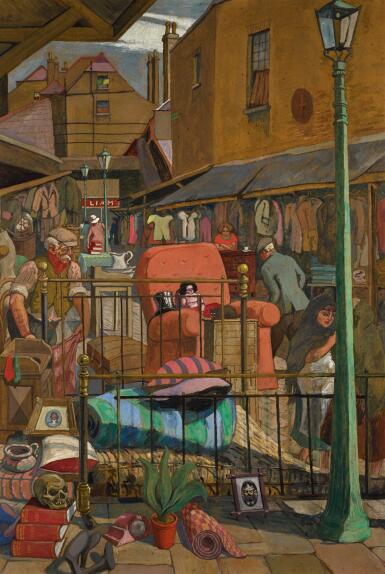
HARRY KERNOFF, R.H.A. | ANGLESEA MARKET
Auction Closed
November 19, 03:20 PM GMT
Estimate
50,000 - 70,000 GBP
Lot Details
Description
HARRY KERNOFF, R.H.A.
1900-1974
ANGLESEA MARKET
oil on board
96.5 by 63.5cm., 38 by 25in.
Painted in 1933.
Purchased directly from the artist in 1968 and thence by descent to the present owner
Animated with the percipient immediacy of a glance down a crowded street, Harry Kernoff’s Anglesea Market offers an affecting window into a vanished thread of Dublin life. Famous for its second-hand clothes, shoes and furniture, the thoroughfare depicted was one of many bustling neighbourhoods in the warren of small lanes around Moore Street demolished in 1972 to make way for the Ilac shopping centre. Warm light infuses the complex composition – throwing shadows across the mercurial tableau – while candid renditions of hawkers and hurrying pedestrians showcase Kernoff’s subtle wit and instinct for caricature. Known to some as an ‘Irish Lowry’ for his stylised and sympathetic portrayals of working-class life, Kernoff’s paintings are quirky and dynamic. Woven into the multi-layered jumble of possessions, acutely-observed details catch the eye like symbols without slipping into poetical romanticising. With nothing surviving of the market today, this lively, distinctive painting has become a valuable record of an evanescent city scene.
Born in London to a Belarussian Jewish family, Harry Kernoff moved to Dublin at the age of fourteen and made it his home for life. Spending his days as an apprentice in his father’s furniture business, Kernoff took night classes at the Dublin Metropolitan School of Art before becoming the first night student to win the Taylor Art Scholarship in 1923. Quickly developing an original and innovative mode of expression that chronicled the modern everyday world and emphasised clarity of form, Kernoff first exhibited at the Royal Hibernian Academy just three years later and continued to do so nearly every year until his death in 1974. He became a full member of the academy in 1936 and won international attention in 1939 when he represented Ireland at the New York World’s Fair. Besides designing sets and costumes for the Dublin theatre scene and executing portraits of literary figures and actors, Kernoff is best known for his many woodcuts and egalitarian paintings of urban daily life. Cherished and reproduced to the point of becoming iconic, Kernoff’s honest depictions of Dublin and her people occupy a firm place in modern Irish popular culture.
